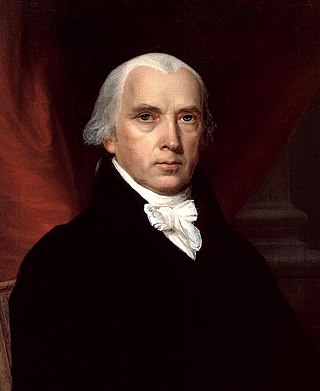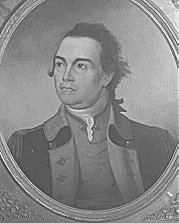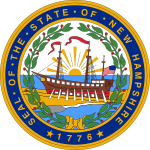
The 1788–89 United States presidential election was the first quadrennial presidential election. It was held from Monday, December 15, 1788, to Wednesday, January 7, 1789, under the new Constitution ratified that same year. George Washington was unanimously elected for the first of his two terms as president and John Adams became the first vice president. This was the only U.S. presidential election that spanned two calendar years without a contingent election and the first national presidential election in American history.

The 1792 United States presidential election was the second quadrennial presidential election. It was held from Friday, November 2, to Wednesday, December 5, 1792. Incumbent President George Washington was elected to a second term by a unanimous vote in the electoral college, while John Adams was re-elected as vice president. Washington was essentially unopposed, but Adams faced a competitive re-election against Governor George Clinton of New York.

The 1796 United States presidential election was the third quadrennial presidential election of the United States. It was held from Friday, November 4 to Wednesday, December 7, 1796. It was the first contested American presidential election, the first presidential election in which political parties played a dominant role, and the only presidential election in which a president and vice president were elected from opposing tickets. Incumbent vice president John Adams of the Federalist Party defeated former secretary of state Thomas Jefferson of the Democratic-Republican Party.

The 1804 United States presidential election was the fifth quadrennial presidential election, held from Friday, November 2, to Wednesday, December 5, 1804. Incumbent Democratic-Republican president Thomas Jefferson defeated Federalist Charles Cotesworth Pinckney of South Carolina. It was the first presidential election conducted following the ratification of the Twelfth Amendment to the United States Constitution, which reformed procedures for electing presidents and vice presidents.

The 1808 United States presidential election was the sixth quadrennial presidential election, held from Friday, November 4, to Wednesday, December 7, 1808. The Democratic-Republican candidate James Madison defeated Federalist candidate Charles Cotesworth Pinckney decisively.

The 1812 United States presidential election was the seventh quadrennial presidential election. It was held from Friday, October 30, 1812, to Wednesday, December 2, 1812. Taking place in the shadow of the War of 1812, incumbent Democratic-Republican President James Madison defeated DeWitt Clinton, the Lieutenant Governor of New York and Mayor of New York City, who drew support from dissident Democratic-Republicans in the North as well as Federalists. It was the first presidential election to be held during a major war involving the United States.

The 1820 United States presidential election was the ninth quadrennial presidential election. It was held from Wednesday, November 1, to Wednesday, December 6, 1820. Taking place at the height of the Era of Good Feelings, the election saw incumbent Democratic-Republican President James Monroe win re-election without a major opponent. It was the third and the most recent United States presidential election in which a presidential candidate ran effectively unopposed. As of 2024, this is the most recent presidential election where an incumbent president was re-elected who was neither a Democrat nor a Republican, before the Democratic-Republican party split into separate parties.
New York is a Democratic stronghold and is considered one of the "Big Three" Democratic strongholds alongside California and Illinois. The following table indicates the party of elected officials in the U.S. state of New York:

The 1822–23 United States House of Representatives elections were held on various dates in various states between July 1, 1822, and August 14, 1823. Each state set its own date for its elections to the House of Representatives before the first session of the 18th United States Congress convened on December 1, 1823. They occurred during President James Monroe's second term.

The 1798–99 United States House of Representatives elections were held on various dates in various states between April 24, 1798 in New York and August 1, 1799 in Tennessee. Each state set its own date for its elections to the House of Representatives, with some after the official start of the 6th United States Congress on March 4, 1799, but before the start of the first session of this Congress in Philadelphia on December 2, 1799. These elections were held during President John Adams term. It was the last congressional session before the move to the new capital at Washington, D.C. Elections were held for all 106 seats, representing 16 states.

The 1813 United States Senate election in New York was held on February 2, 1813, by the New York State Legislature to elect a U.S. Senator to represent the State of New York in the United States Senate.
Elections to the Massachusetts Senate were held during 1788 to elect 40 State Senators. Candidates were elected at the county level, with some counties electing multiple Senators.

Beginning shortly after the city's incorporation as a city in 1846, elections have been held in the mayor of Manchester, New Hampshire. The following article provides information on the elections for mayor in the city during the 21st century.

The 1812 New Hampshire gubernatorial election was held on March 10, 1812.

The 1785 New Hampshire gubernatorial election was held on 8 March 1785 in order to elect the President of New Hampshire. Candidates consisted of John Langdon, George Atkinson, John Sullivan and Josiah Bartlett. Since no candidate received a majority in the popular vote, Langdon was elected by the New Hampshire General Court per the state constitution, despite having come in second in the popular vote.

The 1786 New Hampshire gubernatorial election was held on 14 March 1786 in order to elect the President of New Hampshire. Incumbent Anti-Federalist President John Langdon was defeated in his re-election bid by Federalist candidate John Sullivan, who had initially finished third during the previous President election.

The 1787 New Hampshire gubernatorial election was held on 13 March 1787 in order to elect the President of New Hampshire. Incumbent Federalist President John Sullivan defeated Anti-Federalist candidate and former President John Langdon, 1785 President Anti-Federalist candidate Josiah Bartlett and Federalist judge Samuel Livermore. Since no candidate received a majority in the popular vote, Sullivan was elected by the New Hampshire General Court per the state constitution, despite having come in second in the popular vote.

The 1788 New Hampshire gubernatorial election was held on 11 March 1788 in order to elect the President of New Hampshire. Incumbent Federalist President John Sullivan was defeated in his re-election bid by Anti-Federalist candidate and former President John Langdon, who had initially finished first in the popular vote during the previous President election.

The 1790 New Hampshire gubernatorial election was held on 9 March 1790 in order to elect the President of New Hampshire. Third time Anti-Federalist candidate Josiah Bartlett defeated former Acting President John Pickering, Joshua Wentworth and former delegate to the Continental Congress Nathaniel Peabody. Since no candidate received a majority in the popular vote, Bartlett was elected by the New Hampshire General Court per the state constitution, despite placing third in the popular vote.

The 1824 New Hampshire gubernatorial election was held on 9 March 1824 in order to elect the Governor of New Hampshire. Former Democratic-Republican United States Senator from New Hampshire David L. Morril defeated incumbent Democratic-Republican Governor Levi Woodbury and former Federalist Governor Jeremiah Smith. Since no candidate received a majority in the popular vote, Morril was elected by the New Hampshire General Court per the state constitution.



















